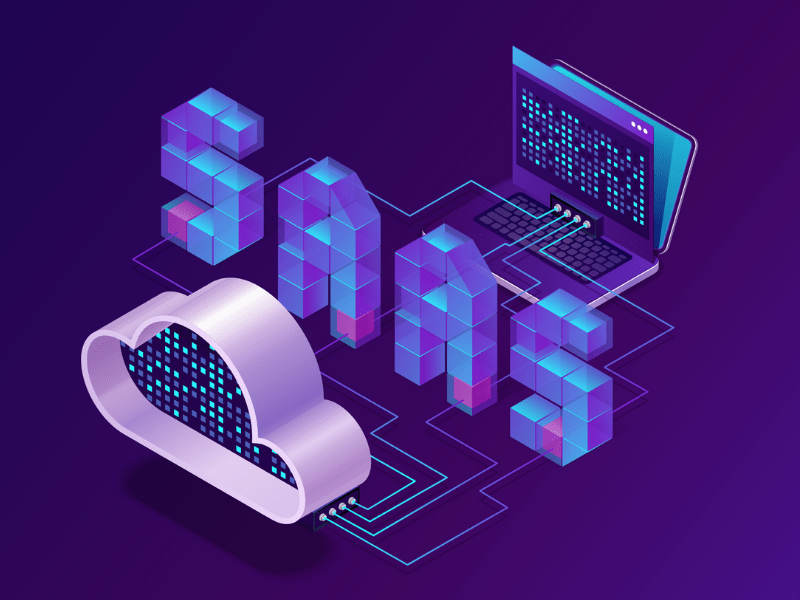SaaS applications that are hosted in the cloud do not need to be installed on your PC. The use of cloud computing gives a number of benefits to SaaS systems, including cost savings. You won’t have to spend money on hardware or maintain it, and you’ll just be charged for the resources your application demands. Scalability is easy to understand and implement. With a few clicks, you may quickly upgrade your plan if your needs change. It’s also simple to cut back on resources or downgrade.
It’s all about accessibility and dependability. A cloud is a distributed network of servers that can be found all over the world. Even if one of the servers fails, your program will continue to function. Then there’s the high-level security, which is maybe most crucial. To ensure that your data is safe, cloud service providers place a strong focus on security. Let’s take a quick look at SaaS before we go any further.
What is Software as a Service (SaaS)?
Software as a service (SaaS) is a means of giving Internet-based access to or use of a program. Rather than installing and maintaining software on your own PCs, you simply access it via the Internet, obviating the need for complicated software and device maintenance.
SaaS programs are also known as web-based software, on-demand software, and hosted software. SaaS apps, regardless of their name, are hosted on a SaaS provider’s servers. The security, availability, and performance of the application are the responsibility of the service provider. On a daily basis, most of us use SaaS programs like Facebook, Dropbox, or Google. At Keitaro, for example, we utilise Google Docs, which is a multi-tenant web-based SaaS service from Google.
From a business standpoint, SaaS is a subscription-based revenue model that monetizes customers’ access for a monthly charge.
How to build a cloud-based SaaS application
Developing a cloud-based saas application development company comes with its own set of issues, which require the correct team members to effectively address. Let’s go over the top five steps to creating a cloud-based SaaS application.
Step 1: Provide your customers with a transparent and dependable service.
According to the SaaS model, you must deliver dependable and continuous service. Certain services, but not all, are willing to be subscribed to by customers.
When an application has the following characteristics, the SaaS business model is usually the best option:
- The application is repeatable and transparent.
- It provides users with financial rewards.
- It has a vast number of prospective users.
When a product appeals to a larger audience, the cloud-based approach is the most profitable for the application’s owner, and it aids long-term business management.
Step 2. Conduct market research
After coming up with a great idea or even getting started on a product, every SaaS team faces the same problem: who wants it and is prepared to pay for it? We normally start designing an application by solving a problem we have or notice in our environment. Start there if you want to undertake proper market research. Begin by asking yourself questions such as who will use this software, is there something similar on the market already, what features do my competitors provide, and so on. Finally, you’ll come to a point where you’ll identify a market need and the opportunity to fill it with your SaaS service.
Step 3. Choose your fighters: select a technology stack
Behind-the-scenes processing necessitates a dependable cloud provider who can host your SaaS platform and make it accessible to users.
To create a dependable cloud app, you must select a dependable cloud host. Ideally, you’ll want to choose one with low beginning costs but the ability to scale as your platform and user base expand. Amazon Web Services (AWS) is a well-known cloud service provider that provides a variety of tools for SaaS developers.
There are various development and programming languages to choose from, but you might consider HTML, CSS, Angular, React, Vue.js, Node.js, Laravel, PostgreSQL, and Apache and Nginx for servers.
Step 4. Select the pricing strategy
Pricing isn’t something that a single department decides on. Marketing, Sales, Product, and Management should all work together to make this conclusion. They help you position, bundle, manage, and target your audience more effectively.
Put yourself in your customer’s shoes when deciding on a pricing plan, and base your decision on the data you acquire. Consider your Customer Lifetime Value to Customer Acquisition (LTV: CAC) ratio when choosing a pricing plan. It can help you figure out if the model will keep your organisation running smoothly. Using the facts at hand, create buyer personas. Conduct a thorough examination of who your clients are and which demographic you’re aiming for. This will enable you to properly place your goods in accordance with their needs.
Create distinct tiers after you’ve defined your buyer personas. Knowing how to tell the difference between what a startup needs and what an enterprise need will help you package and offer your features at different price points, allowing you to advertise more effectively.
Step 5. Gather the right team
One of the most significant things when starting from scratch is the team. Aside from the team’s technical expertise and growth, adhering to the vision and collaborating to develop the best version of the application has a significant impact on the project and the firm.
In today’s fast-changing digital environment, working on a cloud application is a tough and long-term operation that necessitates continual upgrades, feature integrations, and support. Make sure your team is up to the task as well.
Final Thoughts
We’ve described five essential steps for building a successful SaaS application in the cloud. Many factors, such as price and technology stack, will vary based on the niche you’re targeting. There are a number of well-known companies that are generating big money from their fascinating SaaS services, and you should look into them to learn more and lay up the foundations for your own.














